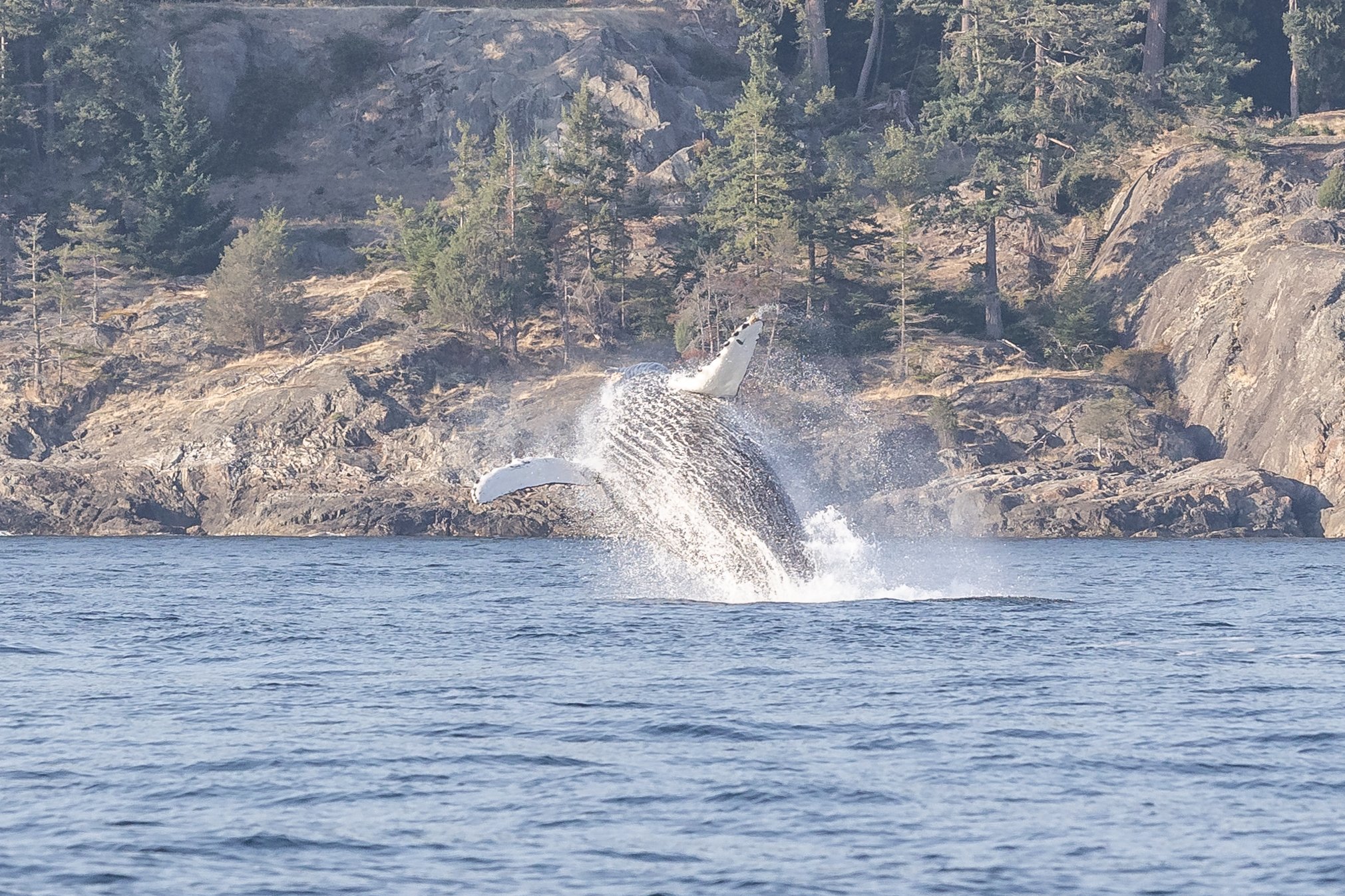September 2, 2023, 3:30 PM - The T090s by the Mainland and a handful of Humpbacks
When we left the dock for the afternoon tour, there was word of a different group of orca that had been found close to the Sunshine Coast. We decided to head over that way and see who might be waiting for us. As we approached to see the Orca, we recognized one of the dorsal fins, it was a male who is just starting to get through the sprouting stage, almost having a 6-foot tall dorsal fin. Piglet! Piglet was travelling with the rest of his family, meaning there were four Orca present:
T090 Eagle ♀ (1980)
T090B Piglet ♂ (2006)
T090C Tigger ♀ (2010)
T090D Kanga ♀ (2017)
These whales seemed like they were on a mission, moving swiftly through the water, only momentarily stopping for what we assumed was a hunt. Even in their hunting, they were fast about it, finishing off whatever they had come across and continuing to head south along the coast. You can see from the photos below that Piglet is starting to get a large, straight dorsal fin. When fully grown the male orca will have a dorsal fin that could be 6 feet in height. They will start to develop this as they go through puberty in their teenage years, reaching full size by the time they’re in their early twenties. At 17 years old, this isn’t too far off for him! We don’t expect to see any growth from the rest of the family, as they have all been identified as female. Eagle is the most obvious since she has given birth to all of the other members of the pod. But the others it might not be as easy.
When trying to determine the sex of an orca you usually need to have a bit of luck! You need to see the bottom side of the whale, and different shapes to their colouration as well as the presence/absence of mammary slits is the best way. The unfortunate part of this is that most of the identifying features for the whales are on the top of the animal, so it can be hard to accurately match the underside to the proper whale. This sometimes leads to mistakes, and sometimes whales we think are female will start to sprout when they get old enough and we have to rethink previous information! There are a few examples of this amongst the Transient Orca population such as Amir (previously Amira), Jude (previously Judy), and Indy (previously Elsie).
After spending some time with the T090s we started back across the Strait of Georgia to return to Nanaimo but we were stopped when we saw a humpback whale blow in the distance.
This whale was a little bit excited, as we saw her breaching, slapping her pectoral fins against the water, and flicking her tail into the air! We were able to determine this whale was Raptor (BCY0528). Raptor is a known female in the area since she has brought some calves back to the Salish Sea over the years. Just like with the orca, determining the sex of a humpback requires a look at the bottom side of the whale, but this time you look for the hemispherical lobe. This grapefruit-sized lump being present means the humpback is female. Sometimes during surface activity like this, you can get lucky and get a shot of this lobe. The other way is just to wait until they bring a calf back since only females will do that.
On the way back across we came across another couple of female humpbacks; Split Fluke (BCX1068) and Divot (BCX1057) travelling together! We don’t really know why humpbacks travel together, but sometimes we find females are more likely to hang out with other humpbacks when they are pregnant! Maybe these two will return with calves next year!
The reason why they’re together doesn’t really matter, we just like seeing them! Soon we continued back to Nanaimo and ended our double-species tour. It was an unforgettable afternoon!
All the photos from the day were taken by Marine Naturalists Ella Hillbrecht and Des Poier.
T090C Tigger. Photo by Ella Hillbrecht.
T090B Piglet beside his youngest sister T090D Kanga. Photo by Ella Hillbrecht.
T090B Piglet. Photo by Ella Hillbrecht.
T090D Kanga, T090B Piglet, and T090C Tigger. Photo by Ella Hillbrecht.
T090B Piglet. Photo by Ella Hillbrecht.
T090C Tigger. Photo by Ella Hillbrecht.
T090D Kanga. Photo by Ella Hillbrecht.
T090 Eagle, T090B Piglet, and T090C Tigger. Photo by Ella Hillbrecht.
T090D Kanga and T090B Piglet. Photo by Ella Hillbrecht.
T090B Piglet from behind. Photo by Des Poier.
Raptor (BCY0528). Photo by Des Poier.
Raptor (BCY0528). Photo by Des Poier.
Split Fluke (BCX1068) and Divot (BCX1057). Photo by Des Poier.
Divot (BCX1057). Photo by Des Poier.
Split Fluke (BCX1068). Photo by Des Poier.
Raptor (BCY0528)’s lovely fluke. Photo by Des Poier.
Raptor tail flicking. Photo by Des Poier.
Raptor breaching out of the water. Photo by Des Poier.
Did you know a breach like Raptor is doing takes the same amount of energy as a human running a marathon? Photo by Des Poier.
Ready for touchdown. Photo by Des Poier.
Raptors pectoral fins out of the water. Photo by Des Poier.
Our open boat Cascadia beside the Gabriola Bluffs. Photo by Des Poier.
A sunset view of ‘The Gap’ - the waterway between Protection Island and Saysutshun (Newcastle) Island. Photo by Des Poier.























